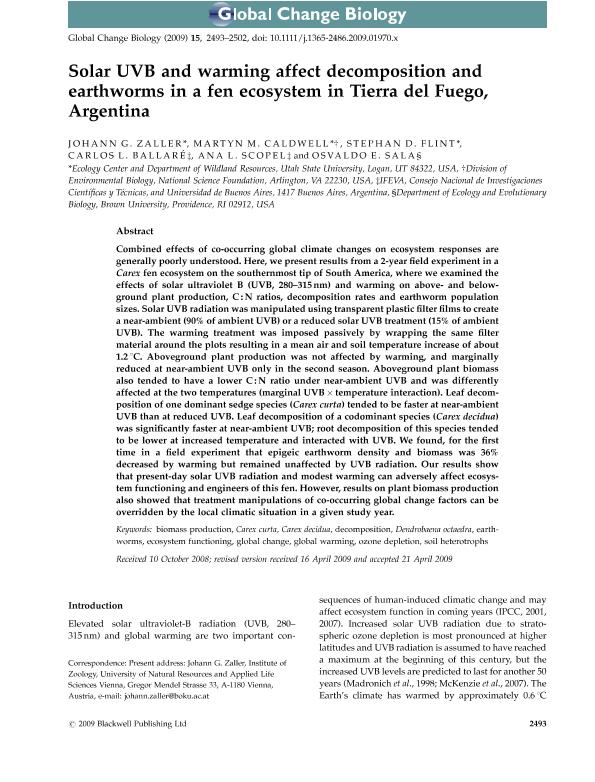Mostrar el registro sencillo del ítem
dc.contributor.author
Zaller, Johann G.
dc.contributor.author
Caldwell, Martyn M.
dc.contributor.author
Flint, Stephan D.
dc.contributor.author
Ballare, Carlos Luis

dc.contributor.author
Scopel, Ana Leonor

dc.contributor.author
Sala, Osvaldo Esteban

dc.date.available
2021-05-03T11:23:41Z
dc.date.issued
2009-10
dc.identifier.citation
Zaller, Johann G.; Caldwell, Martyn M.; Flint, Stephan D.; Ballare, Carlos Luis; Scopel, Ana Leonor; et al.; Solar UVB and warming affect decomposition and earthworms in a fen ecosystem in Tierra del Fuego, Argentina; Wiley Blackwell Publishing, Inc; Global Change Biology; 15; 10; 10-2009; 2493-2502
dc.identifier.issn
1354-1013
dc.identifier.uri
http://hdl.handle.net/11336/131227
dc.description.abstract
Combined effects of co-occurring global climate changes on ecosystem responses are generally poorly understood. Here, we present results from a 2-year field experiment in a Carex fen ecosystem on the southernmost tip of South America, where we examined the effects of solar ultraviolet B (UVB, 280-315nm) and warming on above- and belowground plant production, C:N ratios, decomposition rates and earthworm population sizes. Solar UVB radiation was manipulated using transparent plastic filter films to create a near-ambient (90% of ambient UVB) or a reduced solar UVB treatment (15% of ambient UVB). The warming treatment was imposed passively by wrapping the same filter material around the plots resulting in a mean air and soil temperature increase of about 1.2°C. Aboveground plant production was not affected by warming, and marginally reduced at near-ambient UVB only in the second season. Aboveground plant biomass also tended to have a lower C:N ratio under near-ambient UVB and was differently affected at the two temperatures (marginal UVB × temperature interaction). Leaf decomposition of one dominant sedge species (Carex curta) tended to be faster at near-ambient UVB than at reduced UVB. Leaf decomposition of a codominant species (Carex decidua) was significantly faster at near-ambient UVB; root decomposition of this species tended to be lower at increased temperature and interacted with UVB. We found, for the first time in a field experiment that epigeic earthworm density and biomass was 36% decreased by warming but remained unaffected by UVB radiation. Our results show that present-day solar UVB radiation and modest warming can adversely affect ecosystem functioning and engineers of this fen. However, results on plant biomass production also showed that treatment manipulations of co-occurring global change factors can be overridden by the local climatic situation in a given study year.
dc.format
application/pdf
dc.language.iso
eng
dc.publisher
Wiley Blackwell Publishing, Inc

dc.rights
info:eu-repo/semantics/openAccess
dc.rights.uri
https://creativecommons.org/licenses/by-nc-sa/2.5/ar/
dc.subject
BIOMASS PRODUCTION
dc.subject
CAREX CURTA
dc.subject
CAREX DECIDUA
dc.subject
DECOMPOSITION
dc.subject
DENDROBAENA OCTAEDRA
dc.subject
EARTHWORMS
dc.subject
ECOSYSTEM FUNCTIONING
dc.subject
GLOBAL CHANGE
dc.subject
GLOBAL WARMING
dc.subject
OZONE DEPLETION
dc.subject
SOIL HETEROTROPHS
dc.subject.classification
Otros Tópicos Biológicos

dc.subject.classification
Ciencias Biológicas

dc.subject.classification
CIENCIAS NATURALES Y EXACTAS

dc.title
Solar UVB and warming affect decomposition and earthworms in a fen ecosystem in Tierra del Fuego, Argentina
dc.type
info:eu-repo/semantics/article
dc.type
info:ar-repo/semantics/artículo
dc.type
info:eu-repo/semantics/publishedVersion
dc.date.updated
2021-04-19T14:18:03Z
dc.identifier.eissn
1365-2486
dc.journal.volume
15
dc.journal.number
10
dc.journal.pagination
2493-2502
dc.journal.pais
Reino Unido

dc.journal.ciudad
Londres
dc.description.fil
Fil: Zaller, Johann G.. State University of Utah; Estados Unidos
dc.description.fil
Fil: Caldwell, Martyn M.. State University of Utah; Estados Unidos
dc.description.fil
Fil: Flint, Stephan D.. State University of Utah; Estados Unidos
dc.description.fil
Fil: Ballare, Carlos Luis. Consejo Nacional de Investigaciones Científicas y Técnicas. Oficina de Coordinación Administrativa Parque Centenario. Instituto de Investigaciones Fisiológicas y Ecológicas Vinculadas a la Agricultura. Universidad de Buenos Aires. Facultad de Agronomía. Instituto de Investigaciones Fisiológicas y Ecológicas Vinculadas a la Agricultura; Argentina
dc.description.fil
Fil: Scopel, Ana Leonor. Consejo Nacional de Investigaciones Científicas y Técnicas. Oficina de Coordinación Administrativa Parque Centenario. Instituto de Investigaciones Fisiológicas y Ecológicas Vinculadas a la Agricultura. Universidad de Buenos Aires. Facultad de Agronomía. Instituto de Investigaciones Fisiológicas y Ecológicas Vinculadas a la Agricultura; Argentina
dc.description.fil
Fil: Sala, Osvaldo Esteban. Consejo Nacional de Investigaciones Científicas y Técnicas. Oficina de Coordinación Administrativa Parque Centenario. Instituto de Investigaciones Fisiológicas y Ecológicas Vinculadas a la Agricultura. Universidad de Buenos Aires. Facultad de Agronomía. Instituto de Investigaciones Fisiológicas y Ecológicas Vinculadas a la Agricultura; Argentina. Brown University; Estados Unidos
dc.journal.title
Global Change Biology

dc.relation.alternativeid
info:eu-repo/semantics/altIdentifier/doi/https://doi.org/10.1111/j.1365-2486.2009.01970.x
dc.relation.alternativeid
info:eu-repo/semantics/altIdentifier/url/https://onlinelibrary.wiley.com/doi/full/10.1111/j.1365-2486.2009.01970.x
Archivos asociados
